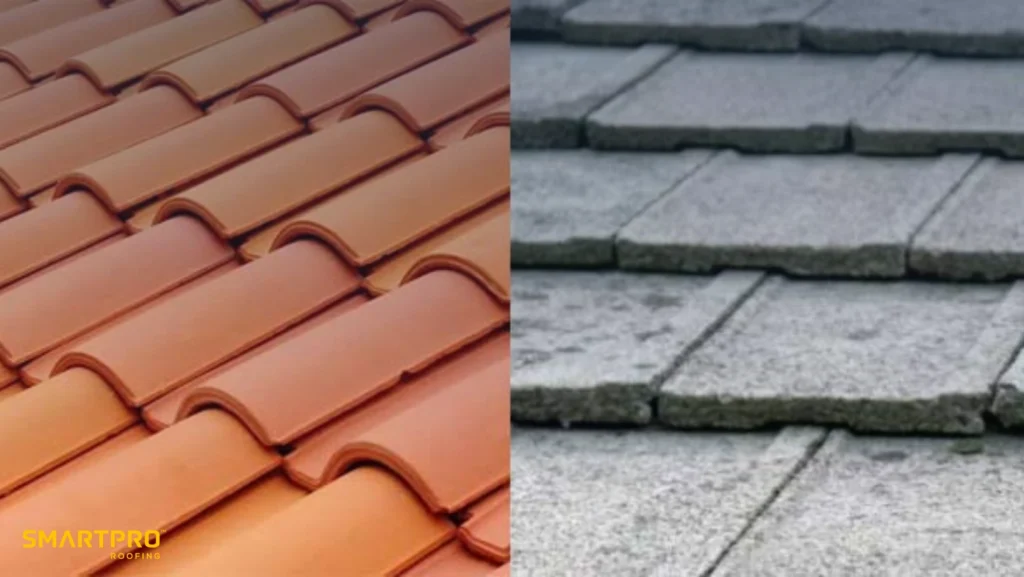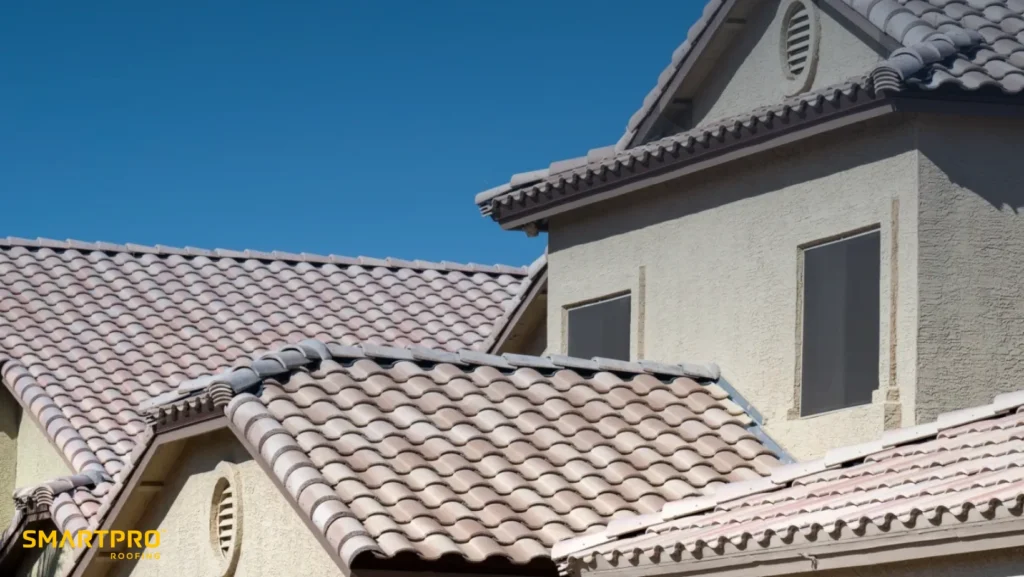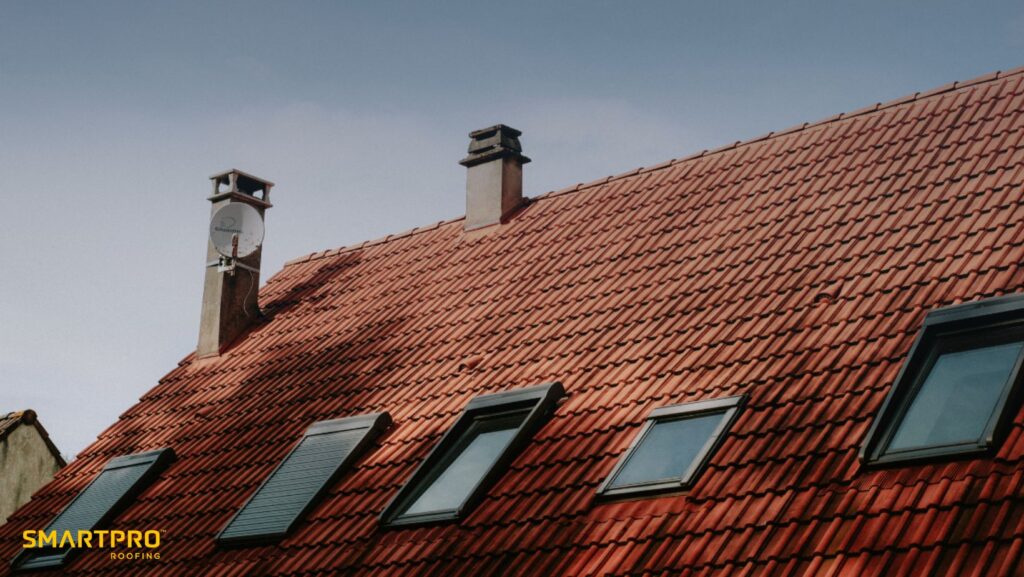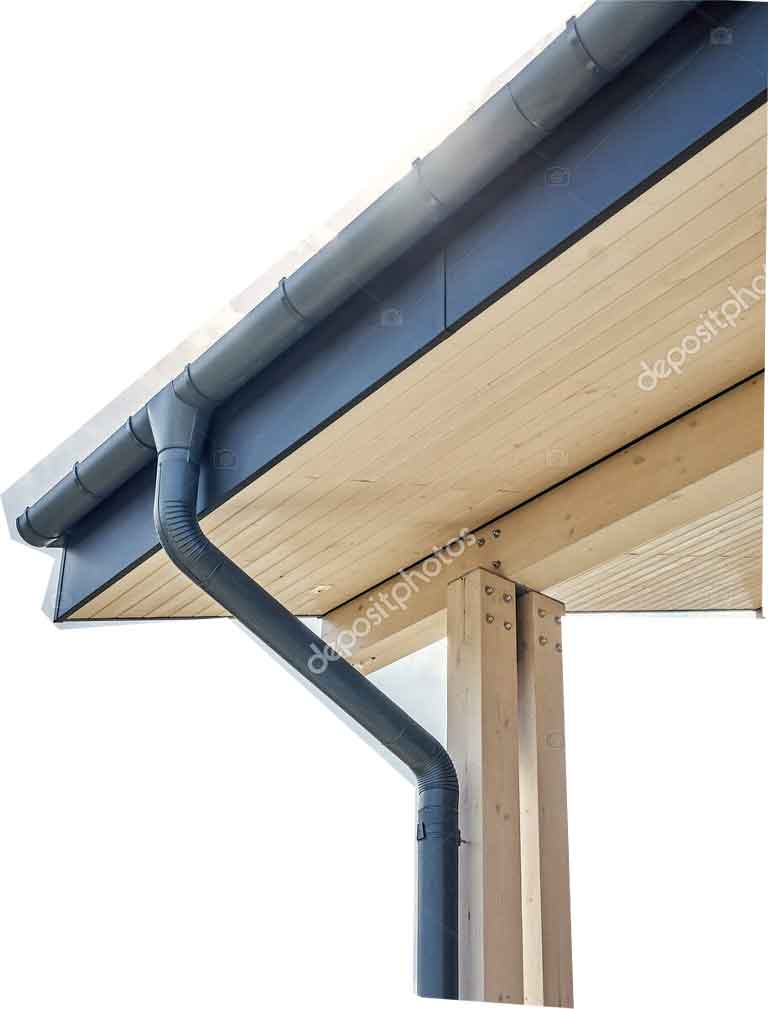Clay roof tiles are typically the better option for heat resistance, low water absorption, and long-term value. They can last 50–100 years with minimal upkeep. However, concrete roofing tiles are more affordable upfront, come in more shapes and colors, and handle impact from debris or hail better. Your choice depends on budget, climate, and roof structure, and SmartPro Roofing recommends clay for premium performance and concrete for cost-effective durability in Florida homes.

Understanding Clay and Concrete Roofing Tiles
When exploring roof tile options, two of the most popular choices are clay tile and concrete tile. Both fall into the category of tiles that are durable materials, but their composition, manufacturing process, and performance vary greatly.
Clay tiles are made from natural clay, shaped and baked at high temperatures. This process gives clay tiles their durable and distinctive color and texture, often associated with Mediterranean, Spanish, and Southwestern architecture. The rich tones of clay roof tiles are naturally locked in during firing, making them resistant to fading even after decades under the sun.
On the other hand, concrete tiles are made from a mix of sand, cement, and water, molded under pressure, and cured to achieve strength. Concrete roofing tiles can be finished in a variety of colors and textures, and concrete tiles come in styles that mimic slate, wood shake, or even natural clay. Because tiles come in a variety of designs, concrete tile offers more flexibility for different home styles.
Both clay and concrete roof tiles are known for longevity, energy efficiency, and their ability to withstand extreme weather. However, the difference between clay and concrete becomes apparent when we compare lifespan, weight, maintenance, and cost.
Clay vs Concrete: Key Differences Every Homeowner Should Know
When choosing between clay vs concrete roof tiles, it’s essential to look at more than just aesthetics. The key differences between these roofing materials influence performance, installation, and long-term value.
- Weight of concrete tiles vs clay: Concrete tiles weigh significantly more than clay tile, which can impact your roof structure requirements. Some older homes may need reinforcement before installing heavy concrete tile roofs.
- Longevity of clay vs concrete: While concrete tiles can last 30–50 years, the longevity of clay tile can extend up to 100 years with proper care.
- Cost of clay vs concrete: Clay tiles are more expensive upfront, while concrete tiles are generally more budget-friendly.
- Climate performance: Clay tiles are more energy efficient and perform better in hot climates, while concrete tiles may need reflective coatings to match their performance.
Clay Roof Tiles vs Concrete Roof Tiles: Quick Comparison
| Feature | Clay Tiles | Concrete Tiles |
| Lifespan | 50–100+ years | 30–50 years |
| Cost | Higher upfront, but lasts longer | More affordable initially |
| Weight | ~600–650 lbs per 100 sq. ft. | ~900 lbs per 100 sq. ft. (heavier than clay) |
| Appearance | Timeless, natural clay finish | Can mimic clay, slate, or wood; tiles come in a variety of styles |
| Energy Efficiency | Clay tiles are more energy efficient; naturally ventilated | Can be coated for heat reflection (concrete tiles can be painted) |
| Water Absorption | ~6% (tiles have a water absorption rate) | ~13% (concrete tiles absorb water more easily) |
| Maintenance | Minimal | Requires sealing in humid/rainy climates |
| Climate Suitability | Excellent in hot, coastal regions | Great for impact resistance and varied designs |
| Structure Requirements | Standard | May require reinforcement due to weight |
Aesthetic Appeal: Clay Tile vs Concrete Tile
If you’re deciding between clay or concrete, appearance is often one of the first considerations.
Clay roof tiles are made with a natural elegance that pairs beautifully with classic architectural styles. The earthy reds, oranges, and browns of clay tiles offer timeless charm, and because tiles are naturally colored during firing, they resist fading even under harsh sunlight. Clay tiles are considered a premium choice for homeowners who value tradition and authenticity.
Concrete tile, on the other hand, offers unmatched versatility. Concrete tiles come in an array of shapes and finishes, and painted concrete tiles may even replicate the look of natural clay. Tiles come in a wider range of colors, from cool grays to deep greens, making concrete tile a flexible roofing material for both modern and traditional homes.
While compared to clay tiles, concrete tiles are heavier, the design flexibility means they can complement nearly any type of tile roof. Whether you’re installing clay for its heritage value or opting for concrete tile installation for customization, both options enhance curb appeal in different ways.
Weight Considerations and Roof Structure Requirements

Weight is one of the most significant key differences between clay tile and concrete.
Concrete tiles can weigh up to 900 pounds per square (100 square feet), while clay tiles typically range from 600 to 650 pounds. This difference in the weight of concrete vs clay means that concrete and clay tiles can’t always be swapped without assessing the roof structure first.
If you’re replacing lighter roofing materials like asphalt shingles, concrete tiles need additional framing support. Tiles require a strong base to ensure the roof can handle long-term stress. Concrete or clay tiles may both require reinforcement for older homes, but concrete tiles are heavier and more likely to necessitate upgrades.
This is why when it comes to choosing between clay and concrete, structural evaluation is a must. Ignoring weight considerations can lead to costly retrofits later, which may offset the initial savings of concrete tile being cheaper than clay tile.
Durability and Longevity of Clay and Concrete Roof Tiles
When it comes to how long tiles can last, clay tiles are durable enough to reach 50–100 years of service life, making them one of the longest-lasting roofing options available. The longevity of clay is thanks to its resistance to UV rays, fire, and moisture damage. In coastal or desert environments, clay tiles are also ideal because they resist salt and heat better than many other roofing materials.
Concrete roofing also delivers impressive durability, with concrete tiles can last 30–50 years. Concrete and clay both perform well under most conditions, but compared to concrete tiles, clay is less prone to color fading. However, concrete tiles absorb water at a higher rate, which can cause erosion or moss growth in damp climates unless tiles can be painted or sealed.
While clay tiles are less impact-resistant and may crack under heavy foot traffic, concrete tiles also require periodic maintenance in wetter climates. Ultimately, tile roofs offer decades of protection, but the longevity of clay tile makes it a better option for those prioritizing lifespan over cost.
Cost Comparison: Clay Tile Roof vs Concrete Tile Roof
For many homeowners, the cost of clay versus concrete is a deciding factor. On average, a clay tile roof can cost anywhere from $10–$18 per square foot installed, while concrete tile roof installations typically range from $7–$10 per square foot. This makes concrete tiles are generally more budget-friendly upfront.
However, cost isn’t just about the purchase price. Tiles are more expensive when you factor in installation complexity, reinforcement for heavier roofs, and long-term maintenance. Concrete tiles may require additional support due to their weight, which increases labor and material costs. Clay tiles are more expensive initially, but thanks to the longevity of clay tile, they can save money over decades by avoiding premature replacement.
Compared to clay tiles, concrete often requires more maintenance in humid or cold climates due to higher water absorption. Tiles have a water absorption rate that affects weight and performance, something worth considering for homes in rainy regions. Over time, clay tiles are generally the better long-term value for those willing to invest more upfront. Still, if the budget is tight, concrete tile remains an excellent roofing option that offers quality and style without the premium price.
Performance in Hot and Cold Climates

Climate plays a huge role in choosing between clay and concrete. In hot, sunny regions, clay tiles are more energy efficient because their porous structure allows air to circulate beneath them. This natural ventilation helps keep attic spaces cooler, reducing air conditioning use and energy bills. For homeowners in places like Arizona, Texas, or Southern California, clay tiles offer unmatched thermal regulation.
Concrete roofing tiles, while strong and durable, absorb more heat than clay. Without additional ventilation or reflective coatings, they can transfer more heat into the home. However, concrete tiles can be painted with reflective finishes to improve performance in hot climates.
In cold or wet climates, concrete tiles also perform well thanks to their impact resistance and ability to handle freeze-thaw cycles. Clay tiles may be more prone to cracking in severe freeze conditions, but modern manufacturing has improved their resilience. When it comes to weather versatility, clay and concrete tiles both hold their own, your location will ultimately determine the best for your home.
For homes in regions like Florida, Arizona, or Texas, clay tiles cannot be matched for thermal regulation and aesthetic compatibility. Read more about regional guidance in our roof replacement tips.
Water Absorption and Moisture Resistance
Water absorption is another key factor when comparing clay vs concrete. Clay tiles typically have a water absorption rate of around 6%, which means they remain lighter even during heavy rain. Concrete tiles absorb water at a higher rate, close to 13%, making them heavier when wet and more susceptible to moss or algae growth.
This difference impacts not only durability but also maintenance needs. In humid or coastal climates, concrete tiles need sealing or painting to reduce water absorption. Tiles can be painted with protective coatings that help extend life and prevent moisture damage.
Clay tiles are also naturally moisture-resistant and less likely to suffer from surface erosion. This makes them a solid choice for homes near the ocean or in regions with frequent storms. While clay or concrete tiles can both last for decades, homeowners in wetter climates may find clay to be the better option due to lower water retention.
Environmental Impact of Clay and Concrete Roofing
Both clay roofing and concrete roofing are considered environmentally friendly compared to many other roofing materials like asphalt. Clay tiles are much considered sustainable because they are made from natural clay and can be recycled at the end of their lifespan.
Concrete tiles are made from abundant materials like sand, cement, and water, and have a relatively low manufacturing footprint. Additionally, tiles are also energy-efficient roofing solutions that help reduce heat gain in summer and heat loss in winter.
However, clay or concrete roof tiles are heavy, meaning transportation and installation require more energy than lighter roofing. Still, tile roofs offer superior longevity, which reduces waste from frequent replacements. For eco-conscious homeowners, both options are viable, but clay tiles are more energy efficient in warm climates, making them slightly greener for sunbelt states.
Which Roof Tile Is Best for Your Home?
If you value longevity, thermal efficiency, and timeless style, clay tiles are the premium choice. While they require a higher upfront investment, they can last over a century and perform exceptionally well in Florida’s heat and coastal conditions.
For homeowners with a tighter budget, concrete tiles provide an excellent alternative. They offer decades of durability, withstand impact well, and can mimic the look of natural clay. Tiles come in a variety of styles to complement both modern and traditional homes.
When choosing between clay and concrete, consider your roof structure, climate, and budget. Concrete tiles are heavier than clay, and in some cases, additional structural reinforcement may be required. Both materials deliver beauty, protection, and longevity, your priorities will determine the best fit for your home.
The Best Choice for Your Home
In Florida, we factor in climate, structure, and budget to recommend the ideal roofing option. For coastal or luxury properties, clay roofing is often the better choice for energy savings and extended lifespan. For cost-conscious homeowners, concrete roofing tiles provide strength, versatility, and design flexibility.
SmartPro Roofing specializes in both clay and concrete roof tiles across Florida, offering precision installation, structural reinforcement, and ongoing maintenance. With our SmartQoute Tool, you’ll get your exact pricing in under an hour using advanced satellite imagery, making it easy to compare your options side by side.
Explore more about the different types of roofs and compare roof material options with our SmartQoute Tool to find the right fit for your home.
FAQs
- What lasts longer, clay or concrete roof tiles?
Clay tiles are extremely durable, with the longevity of clay tile often exceeding 100 years. Concrete tiles can last 30–50 years, making clay the winner for lifespan. - Are clay tiles more expensive than concrete?
Yes. Clay tiles are more expensive upfront, but their long life can make them more cost-effective over decades. Concrete tiles are generally cheaper to install. - Which is better for Florida’s heat – clay or concrete?
Clay tiles are more energy efficient thanks to their natural ventilation properties. Concrete tiles can be painted with reflective coatings to improve thermal performance. - Do concrete tiles weigh more than clay tiles?
Yes. Concrete tiles weigh more than clay tiles typically, which can require structural reinforcement. Weight of concrete tiles is around 900 lbs per 100 sq. ft., while clay averages 600–650 lbs. - Can I walk on clay or concrete tiles?
Both can be walked on carefully by trained professionals. However, clay tiles may crack more easily under foot pressure compared to concrete.











